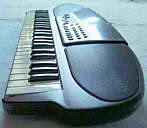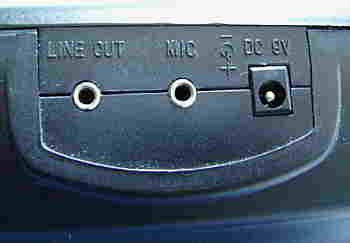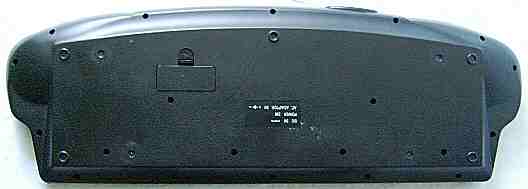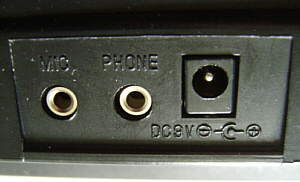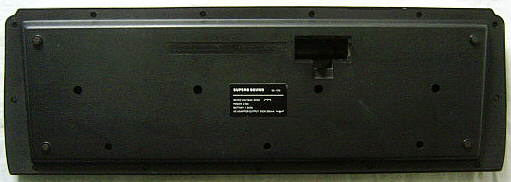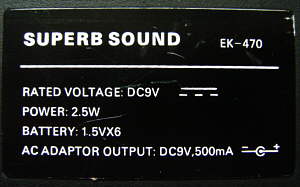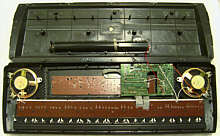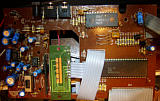| |
 Superb Sound EK-470
Superb Sound EK-470 |
|

FM keyboard
with bizarre lo-fi tekkno sounds
|
 |
Superb Sound EK-905
This midsize FM keyboards from 1995 (PCB date "95.6.17.") was apparently
a close relative of the great
Fujitone 6A
(see there); its 100 sound bank has similar sound names and shares most
of the wonderful grainy tekkno synth preset sounds of the latter, using
the same 2 operator FM sound generator. But unlike the latter, most of
the natural instrument preset sounds here are so extremely off that its
programmer must have been drugged or deaf. Imagine, you select a "marimba"
with sustain and get a snare drum!, select "oboe" and get extremely harsh
distorted C64 synth strings - or select "brass ensemble 1" and get a synth
noise which atonal bass range that sounds like a cross of a helicopter
and a didgeridoo!
Most instrument preset sounds also contain an annoyingly strong 4Hz
wahwah tremolo (like with "bagpipe" on Fujitone 6A), which makes
also those ones sound unnecessarily artificial, those timbre would be otherwise
ok. Unlike Fujitone 6A, this instrument has no drumpads and also
contains neither 4 operator sounds nor any complex envelope tricks (mandolin
ring, siren effects etc.), but great is that it has portamento (although
not adjustable) to make wonderful grainy howling glide tones. Interesting
is also the octave up/ down button, which shifts the keyboard range of
newly played notes by an octave. But in comparison with the noble sounding
6A,
the sound is colder, thinner and has (at least through internal speakers)
way less bass. The percussion is made from typical electronic sounding
thin FM drums. The accompaniment patterns are quite standard but have each
an intro, fill-in and ending, and they accept also disharmonic key combinations
and not only those few ones considered "chords" by the establishment. Bass
and chord can be quickly selected from 5 preset sounds using a slider,
and the quick responding single digit rhythm number entry behaves like
OBS buttons.
main features:
-
49 midsize keys
-
polyphony 6 notes (only 2 with accompaniment)
-
2 speakers (quite bassless with unpleasant midrange resonance, mono)
-
100 preset sounds {piano 1..2, honky-tonk piano, electric piano 1..2, harpsichord
1..3, honky-tonkclavi, glass celesta, reed organ, pipe organ 1..2, electronic
organ 1..2, jazz organ, accordion, vibraphone, marimba 1..2, trumpet, mute
trumpet, trombone, soft trombone, horn, alpenhorn, tuba, brass ensemble
1..3, flute, panflute, piccolo, synth, bass clarinet, oboe, bassoon, saxophone,
bagpipe, woodwinds, violin 1..2, cello, strings, electric bass, slap bass,
wood bass, synth bass, banjo, mandolin, classic guitar, jazz guitar, folk
guitar, hawaiian guitar, ukulele, koto, shamisen, harp, harmonica, music
box, brass & marimba, flute & harpsichord, oboe & vibraphone,
clarinet & harp, violin & steel drum, handsaw, synth brass, metallic
synth, sine wave, reverse, human voice 1..3, whisper, whistle, gurgle,
bubble, raindrop, popcorn, drip, dog pianist, duck, baby doll, telephone
bell, emergency alar, leaf spring, comet, fireworks, crystal, ghost, hand
bell, chimes, bell, steel drum, cowbell, synth tom 1..2, snare drum, machine
gun, wave}
-
10 quasi- OBS preset rhythms {pops, 16 beat, country, smaba, bossa nova,
disco, march, swing, 12 beat, waltz} (each selected by 1 cipher button)
-
cipher buttons {'0'..'9'} to select preset sounds and rhythms
-
main volume slider
-
accompaniment (with rhythm) volume slider (5 steps, no off)
-
sustain & vibrato button
-
rhythm intro/ fill-in & ending buttons
-
auto- accompaniment switch {off, single, A.B.C., auto chord, auto bass}
(only manual chord with rhythm off).
-
OBS bass preset sound slide switch {wood bass, e guitar, piano, trumpet,
harpsi chord}
-
OBS chord preset sound slide switch {default, horn, trumpet, clarinet,
viloin}
-
octave select button (high, low)
-
portamento button
-
tempo +/- buttons (32 steps, lowest is fastest)
-
2 digit LED display (indicates tempo, preset sound, preset rhythms, metronome
LEDs}
-
sound generator based on 2 operator FM (with noticeable zipper noise; possibly
also lower DAC bit resolution and polyphony than usual)
-
CPU= "CIL-22, 206, 9332PX005" (64 pin DIL) + FM sound IC= "HX-881(1), C
I" (24 pin DIL)
-
demo melody "Take a Chance On Me" by Abba (cycles through
many sounds)
-
jacks for AC- adapter, microphone, line out
 |
 |
modifications:
-
polarity protection diode added.
notes:
This tablehooter was made by the infamous company Superb Sound,
who also released the horrible Superb
Sound EK-91DX mini keyboard, and as you can imagine, the control
panel is full of Engrish misspellings, and the German language part of
the manual is even worse. Unlike that mini keyboard, the Superb Sound
EK-905 is at least reasonable playable and has nice OBS controls, although
the sound set of the 100 sound bank is rather a bad joke than a credible
attempt of programming realistic instrument timbres. (These simple 2 operator
FM are capable to do this much better - audible on Yamaha
PSS-390 or PSS-780.) At
least there are many lovely synth effect sounds on it, like known from
Fujitone
6A (which shares most preset sound names with it, despite especially
the instrument (not effect) sounds are made very different). The black
case with its semi- oval speaker grills reminds to early 1990th ghettoblasters,
and like with these, the display rim and some headings are printed in gold.
The fairly dark printing on the control panel is badly readable under non-
optimal lighting conditions. The black keys have no protection against
bending upward and thus may crack off easily. Strange is that this instrument
sounds rather thin, bassless and a little cold, while all my other non-
Yamaha FM keyboards have a nicely warm timbre. Possibly the DAC bit resolution
is lower, but it may also be amplifier feedback loop distortion. The main
voice polyphony is also only 6 notes, while comparable keyboards normally
have 9 with rhythm off. The case design has some similarities with Steepletone
SEK-929; a silver version of the same case was later used for the
Elta
KE-491, which also sounds thin and shares PCB construction details
with the EK-905.
The 100 sound bank includes most of the favourite Fujitone
6A synth sounds (see there) like "hand bell", "fireworks", "leaf
spring", "hand saw", "metallic synth", "human voice" 1..3 etc., but the
natural instrument sounds are very different and also some synth sounds
differ, because the EK-905 has neither complex envelope tricks (mandolin
ring, siren effects) nor 4 operator sounds. Thus e.g. the "machine gun"
doesn't go "brrrt" but only fires one shot, the "synth-tom" 1..2 don't
go pitchbend down and the "dog pianist" sounds much thinner by the lack
of a subvoice. Annoying is that some sounds are even identical (e.g. "comet"
= "crystal"). The natural instrument imitations are not at all natural
but are partly ridiculously off, and most contain an annoyingly strong
4Hz wahwah tremolo (like with "bagpipe" on Fujitone 6A) with audible
zipper noise, that makes them completely unnatural (fortunately there are
also few sounds without). In the following I will not mention this particularly,
but only explain sounds those are otherwise very special. Partly they contain
harsh and grainy digital noises, those almost remind to My
Music Center despite the sound generator is very different. E.g.
"harpsichord2" almost rings like a telephone or mandolin by its extreme
tremolo and has a very atonal bass range; 3 is shorter. "honky- tonkclavi"
has a similar, but less thin ringing timbre. "marimba" 1 & 2 are identical,
and the sustain button adds noise to them and thus turns them into a sort
of reverbing snare drum(! | short key presses cause longer notes). The
"soft trombone" is rather a very pure sine wave organ tone (does not decay,
no tremolo). The "brass ensemble1" resembles with higher notes a mildly
distorted clarinet with that infamous tremolo, but in the bass range it
gradually distorts more and turns into an atonal bassy synth noise which
sounds like a cross of a helicopter and a didgeridoo! 2 sounds of tuba,
while 3 resembles a dull wooden pipe organ rank (with only mild tremolo).
"synth" is just a very short clarinet tone, while "oboe" otherwise is an
massively harsh distorted C64 synth strings timbre that also reminds to
a 3 bit sample of a human chorus or the like (very un-FM); it also goes
into the My Music Center direction, although even way grainier.
The "bagpipe" is similar distorted and has a farty bubbling black FM bass
range. Also "violin2" has grainy distortion in its strong tremolo, despite
the timbre is still recognizable. "strings" is similar, but very hollow
(thin in the treble range, brassy in the bass). The "banjo" is rather a
harp, while "mandolin" is too metallic (typical FM timbre). "classic guitar"
is brassy and may be best an e-guitar (with the severe tremolo); the other
guitars are not better. The "ukulele" is almost a steel drum with bubbling
FM bass range. The so-called "shamisen" is here a snare instead of a picked
string (with and without sustain button). The "harp" is rather an e-bass.
"flute & harpsichord" misses the flute and resembles "harpsichord1".
"oboe & vibraphone" is a sustaining bright and grainy metallic synth
timbre with long sustain: high short notes resemble a banjo (no similarity
with what the name suggests). "clarinet & harp" lacks the clarinet
and resembles an e-bass. "violin & steel drum" lacks the violin. Possibly
with these preset dual voice sounds the programmer was instructed to use
the 4 operator mode to layer 2 sounds, but he couldn't figure out how and
thus programed only one instrument timbre. "whisper" is a flute with slow
attack phase (fades louder) and long sustain. "whistle" resembles a high
sine wave organ tone. "dog pianist" has here only a thin, sitar- like timbre
with tremolo (on Fujitone 6A there is a 2nd subvoice). "duck" is
a metallic synth brass with tremolo. The "telephone bell" doesn't ring,
but only makes a clang with the grainy tremolo. "emergency alar" sounds
just like a trombone (some tremolo, misses the siren howl and the 'm' in
its name). "bell" sounds nasal with a lot of that grainy tremolo. The "wave"
is an ocean wave noise that hisses louder and then slowly fades silent
(no automatic repeat).
Great is also that (like most FM keyboards) the timbres are time- dynamically
playable, i.e. the timbre of notes changes depends on how long a key is
pressed, which provides a relatively expressive playability despite the
keyboard is not velocity sensitive. The "sus" button adds sustain to the
sounds, during which the tremolo continues. A bit strange is that the release
phase of previous notes is always truncated by newly played notes, which
makes the sustain sound thin and behave rather like on a monophonic instrument.
The "vibrato" button adds vibrato, but with many sounds its effect is almost
inaudible or only appears in the release phase. The "portamento" button
plays glide tones by sliding from one note to another; the duration depends
on the distance between both notes. Unlike other keyboards, the active
portamento here always slides from one note to another and not only when
both keys are held. With the "up /down" button the octave range of the
keyboard can be switched by 1 octave, which does not change the pitch of
held notes. Selecting a new preset sound with held notes also changes the
timbre of these, which can be used as a sound effect since the cipher buttons
respond rapidly.
The percussion has the typical electronic FM timbre known from the OPL3
"MIDI synth" of early PC soundcards. The accompaniment patterns are quite
standard but have each an intro, fill-in and ending. The into and fill-in
is identical and a little long for a fill-in; it also contains no accompaniment.
In fingered mode ("A.B.C.") the accompaniment also accepts any disharmonic
note combinations and not just establishment chords. The chord track in
fingered mode can be disabled by selecting "auto bass", which plays the
chord timbre manually in the left keyboard section. The "auto chord" mode
mutes the bass and behaves like the fingered chord mode. The "auto accomp"
mode slider can be also used for quickly muting the running accompaniment.
Strange is that with rhythm off there is no single finger chord mode, but
it always switches into fingered mode (without bass). The bass and chord
timbre can be switched among each 5 preset sounds by quickly responding
sliders, those also affect held notes and nicely work as a realtime sound
control. The chord preset sound "default" selects one of the other 4 depending
on the selected rhythm. Due to the 10 rhythms are selected by 1 digit numbers,
the quickly responding cipher buttons work here like OBS rhythm select
buttons and thus can be used to switch among running rhythms, or to quickly
trill among 2 of the "default" sounds with rhythm off. Bizarre is that
the tempo buttons use "31" for the slowest, and "0" for the fastest tempo;
pressing these buttons also halts the running rhythm for a fraction of
a second.
The demo melody is a polyphonic and fairly nice arranged version of
"Take a Chance On Me" by Abba, which cycles through many
sounds but sometimes changes the chord a bar too late and thus doesn't
sound really professional.
Superb Sound EK-470
This midsize tablehooter from 1996 (sticker inside case) is almost identical
with the EK-905 and was likely its direct
predecessor. Even the many typos on the control panel are the same. It
was also released as MusicTime Keyboard 310 (different button colours,
seen on eBay).

Only the case is more rectangular and instead of slide switches it has
each 5 buttons for the OBS bass preset and chord preset sounds. The CPU
is "CIL-22, 206, 9625XX004", the sound IC "356, HX881(1), 9625" and there
is a polarity protection diode. The cheapish wiring lacks the typical plugged
cables of EK- keyboards and the darker PCBs with flimsy grey ribbon cables
rather resemble Angeltone.
A direct EK-905 successor was released as Super Sound Brand - SBS
EK-906 (same case, but hardware likely like Yongmei
YM-2100, seen on eBay). Another bizarre sounding FM keyboard
full of sound glitches is the Majestic
EK-660, which was possibly a predecessor. A successor of the EK-905
was the Elta KE-491 (similar case
shape, MIDI-out, simple synth). Another 49 midsize keys FM tablehooter
with bizarre lo-fi sounds was the Leetone
PF-50 (with MIDI- out).
| removal
of these screws voids warranty... |
|
|
 |

|
|
| |
back
|
|
 Superb Sound EK-470
Superb Sound EK-470
 Superb Sound EK-470
Superb Sound EK-470

